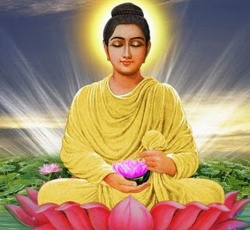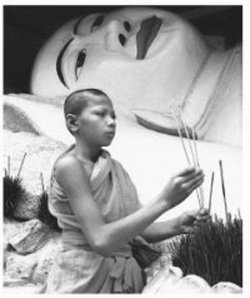Three higher trainings
Jump to navigation
Jump to search
The three higher trainings (Skt. triśikṣa; Tib. ལྷག་པའི་བསླབ་པ་གསུམ་, lhagpé labpa sum, Wyl. bslab pa gsum) are the trainings in:
- discipline (Skt. adhiśīlaśikṣa; Tib. ཚུལ་ཁྲིམས་ཀྱི་བསླབ་པ་, Wyl. tshul khrims kyi bslab pa),
- meditation (Skt. samādhiśikṣa; Tib. ཏིང་ངེ་འཛིན་གྱི་བསླབ་པ་, Wyl. ting nge 'dzin gyi bslab pa) and
- wisdom (Skt. prajñāśikṣa; Tib. ཤེས་རབ་ཀྱི་བསླབ་པ་, Wyl. shes rab kyi bslab pa).
These trainings are called “higher” because, unlike certain other non-Buddhist rituals and meditation practices, they actually lead to liberation and omniscience.
Sogyal Rinpoche writes[1]:
- The Tibetan word for discipline, tsultrim, literally means ‘acting appropriately’. The purpose of discipline is to simplify our lives. Discipline is a way of clearing our minds, preparing the ground, and creating the right environment, or a way of being that is conducive to positive and happy states of mind.
- Meditation is the actual method of transforming the mind. When, through meditation, the mind is transformed, what dawns is wisdom, or prajña. With wisdom, you can simplify your life even more, so bringing more discipline, because you have the clarity and discernment to see what you should pursue or abandon. Then, even though you may be living in a complex world, you will possess an inner simplicity.
- To simplify your life means you will have more time for meditation practice. When you practise, the whole point is to purify your ordinary mind and bring more wisdom. So, discipline supports meditation, through meditation you develop wisdom, and wisdom will create an environment of greater simplicity in the mind, naturally inspiring more discipline. This is the constantly turning ‘wheel of happiness’.
Alternative Translations
- three higher educations (Robert Thurman)
Footnotes
- ↑ A Treasury of Dharma, page 31.
Further Reading
- Dilgo Khyentse Rinpoche, Zurchungpa's Testament: A Commentary On Zurchung Sherab Trakpa's Eighty Chapters Of Personal Advice (Ithaca: Snow Lion Publications, 2007), chapters II, III & IV.
- Dzogchen Ponlop, Rebel Buddha (Boston: Shambhala Publications, 2010), Ch. 7, 'The Three Trainings'.
- Khenpo Ngawang Pelzang, A Guide to the Words of My Perfect Teacher, translated by Padmakara Translation Group (Boston & London: Shambhala Publications, 2004), pages 6-7.
- Thinley Norbu, The Small Golden Key (Shambhala Publications, 1999), ‘9. The Tripitaka and the Three Trainings'.

